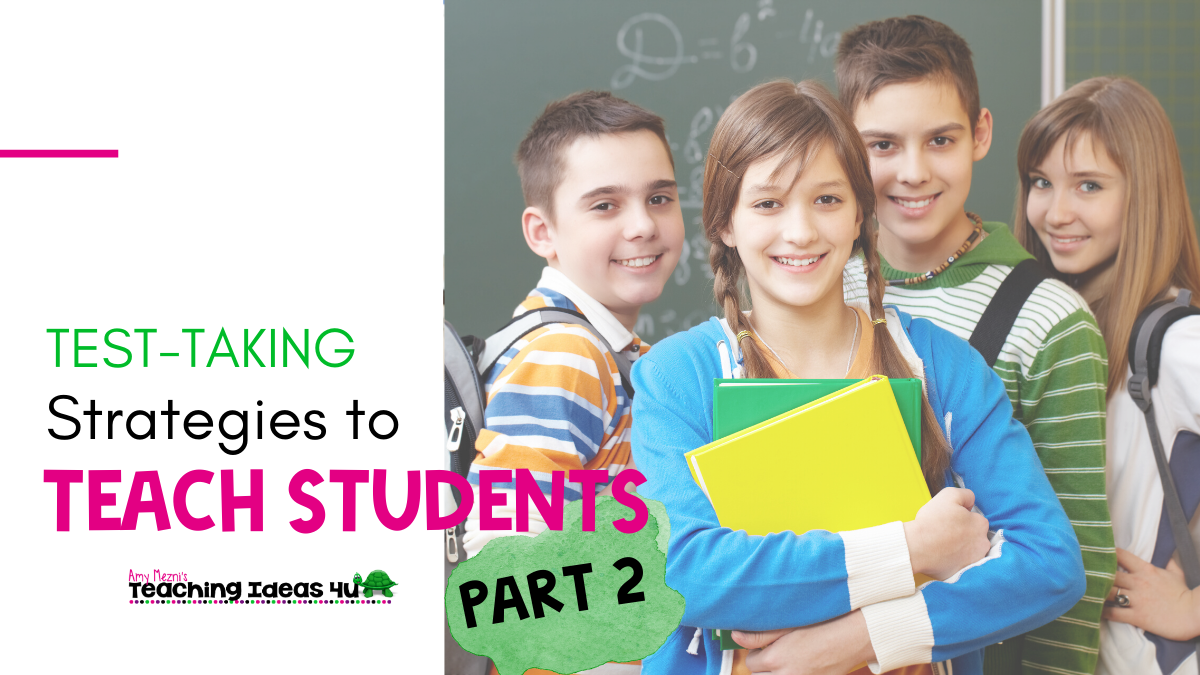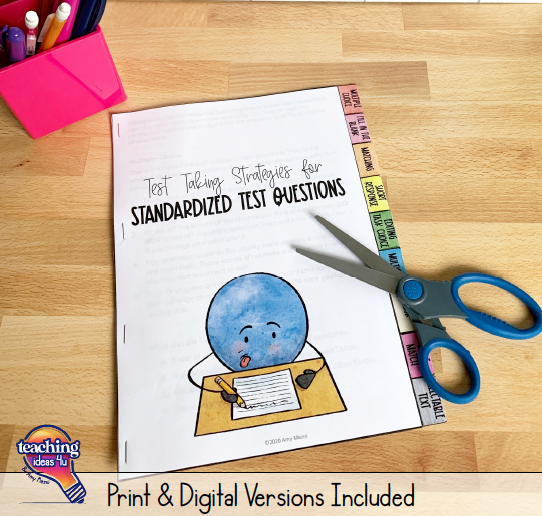Test Taking Strategies You Need To Teach Your Students Part 2
Last week, I discussed ten test-taking strategies students could use on multiple choice questions. These strategies help students eliminate answer choices when they aren’t sure of the correct answer.
This week, I want to discuss strategies to use for the different types of test questions students may see on tests (both classroom assessments and standardized tests). The most common question formats are:
multiple-choice
matching
fill-in-the-blank
short response
The Florida Standards Assessment (FSA) also uses:
table match
EBSR (evidence-based selected response)
multiselect
selectable text
editing task choice
Beneath each question type, I will provide a short explanation of the format, then steps students can use when answering that type of question.
Different Types Of Test Questions
Matching
Matching questions have two columns. Students usually have to match a term, person, event, etc. in one column with a definition or description in another.
In general, these types of questions are easier than others because they use lower-level thinking. However, they can be difficult if they are a large number of items to be paired. Also, students with specific disabilities may find these questions difficult. For example, a student with OCD may have difficulty skipping selections, while a student with vision issues may struggle with looking from one place on the page to another.
Read over the column with fewer words first, so you know what you are trying to identify (vocab, people, events, etc.)
It is easier to scan the shorter word list to find the match, so you should read the column with more information and match it to the other column.
Match all of the pairs you are 100% sure are correct. Skip anything you don’t know.
Cross off choices as you pair them together. You should only cross off the letter or number of the choice – not the entire selection. If you discover later there is a mistake, it is easier for you to change your answers if you can still read the choices.
Go back and match the selections you were not sure the first time.
Fill-in-the-Blank
These types of questions are sometimes written as multiple-choice, but they can also be used with a word bank. They have a sentence with a word or phrase missing, and the students need to determine which answer fits the sentence.
Read all of the possible answers so that you are familiar with the choices.
Read each sentence problem multiple times. Each time, read the sentence with one of the possible answers in place of the blank. Sometimes this helps students to “hear” the correct response.
Fill in the answers that you are sure are correct first, skipping the other problems until the end.
Short Response
Short-response or open-response questions require students to answer a question in sentences. Sometimes these questions only require a few sentences, while at other times they may need one or two paragraphs.
Read the question carefully, underlining the keywords.
Take time to make notes about the topic in the margin or on scratch paper. The notes do not need to be in complete sentences. You just want to write down what you know, so you have a visual to help you formulate your response.
Decide which facts fit the question. Cross off notes that don’t answer the question.
Write your response in complete sentences. The amount of space provided for the answer is a clue as to how long the response is expected to be
Any response is better than leaving it blank. If you don’t know the answer, write anything you know that is related to the topic. You might earn partial credit – or it may even be the correct answer.
Table Match
A table match question uses a grid. Statements are written along the side of the grid, while the options are written across the top. Students have to match the statements to the choices by completing the grid.
For example, there may be 4 characteristics on the side and the name of two characters at the top. Students have to decide which character matches the choices. Another example would be sentences that students need to put in order to retell the story (by putting them in order on the grid.)
Read the directions carefully. Be sure you understand what you are being asked to do.
When you fill in bubbles on the grid be sure you are on the correct line. Use an extra pencil or your finger to hold your place on the grid.
Multiple-Choice
There are many forms of multiple-choice questions. They are a problem that asks a question and then has possible answers (usually 3-4) beneath it.
I will start with general tips, then discuss tips for specific types of multiple-choice questions.
Try to think of the correct answer before reading the choices.
Read all of the choices, even if you think you have found the correct response.
Cross off the letters of the choices you think are incorrect. DO NOT cross off the entire selection. You need to be able to read it if you change your mind later.
Pay attention to words like usually, none, always, except, best, and most likely. These words often make a difference in whether the selection is correct or not.
Your first guess is more likely to be correct than a later guess. Don’t change an answer unless you are 100% sure you have the wrong one.
Vocab Questions
FSA may ask students to determine the meaning of words, providing possible meaning in the answer choices.
Replace the target word with a possible answer, then read the sentence to yourself. Often some of the answer choices don’t make sense in the sentence.
Evidence-Based Selected Response (EBSR)
EBSR questions are usually multiple-choice questions with two parts. Sometimes both parts are multiple-choice, but sometimes one part is not. The answer is Part B is connected to the response in Part A.
Be sure to read each question carefully. Circle the key words in the questions.
Consider how the two questions are connected. The answer selected in Part A should relate to the answer in Part B.
Multiselect
These multiple-choice questions require students to select a specific number of correct responses. They usually have more than four possible answers.
Circle how many correct responses you need to identify.
Follow the other steps for multiple-choice questions.
Double-check that you have marked the correct number of answers.
Selectable Text
These questions use a portion of the text as the answer choices. Each sentence is given a letter. Students need to select the sentence or sentences that answer the question. (Yes, these can be multi select and ask students to find two or more sentences.)
Always read the question carefully. Be sure you understand what you are being asked to do.
Even if you think you remember the selected text, reread the answer choices. Think about which sentences fit the question being asked.
If you are sure a sentence is not the answer, cross off the letter of that choice.
Cross off the letter(s) of the correct responses.
Editing Task Choice
These multiple-choice questions ask students to correct mechanics or grammar. For FSA, a passage with errors is given, with the errors identified in the text. The errors are then pulled out as multiple-choice questions. There are four possible answers, and one is always “correct as is.”
Read the statement. If you don’t understand the statement, go back to the text and read the paragraph for context.
Test the answers by rereading the statement with each of the possible choices in place of the underlined word(s). Often, some choices won’t sound right when you put them in the sentence.
Please note, the above strategies will not help with questions involving spelling.
I hope these strategies are helpful to both you and your students! If you have any other test-taking strategies to share, please email me so I can add them.
Free Resource For Students!
I created a resource for teachers to give to students that will give them strategies for standardized tests. You can get this resource by signing up for my newsletter. Just click here or the photo below.


